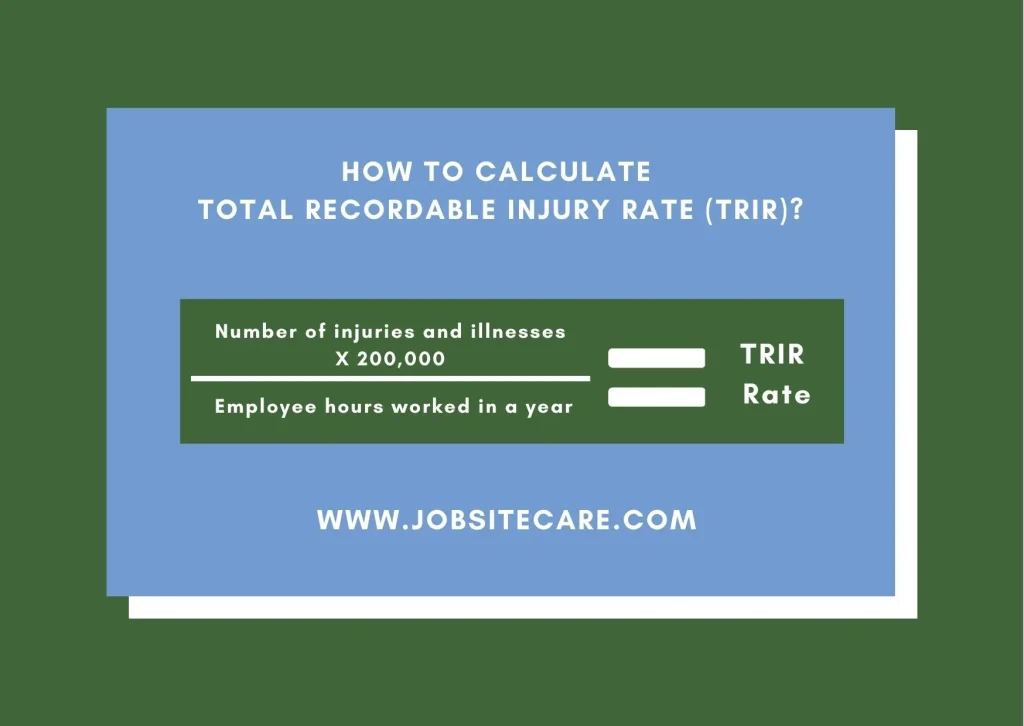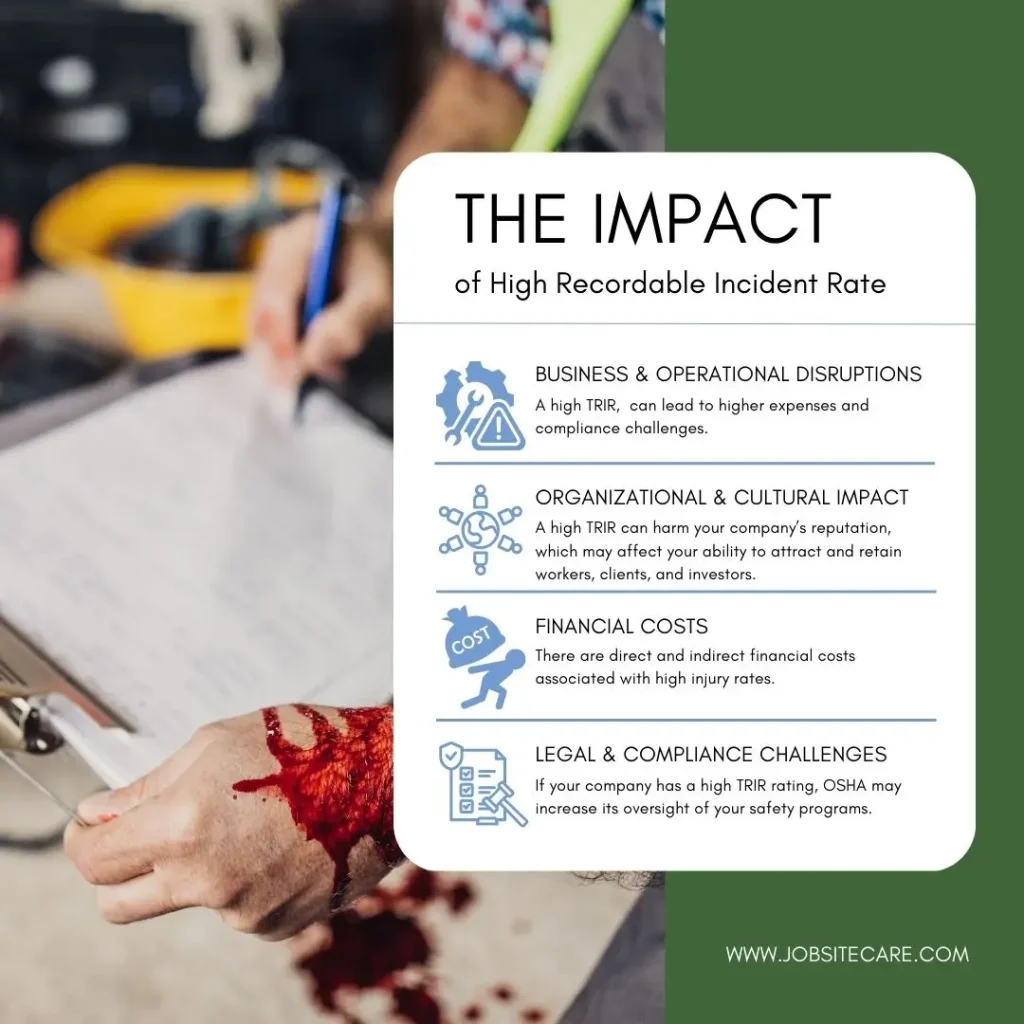TRIR, or Total Recordable Incident Rate, is a metric that assesses a company’s safety performance, offering valuable insights that can help improve workplace safety and internal operations.
For instance, high TRIR rates demonstrate poor workplace safety management, which may contribute to business disruptions, low employee morale, and compliance issues.
On the other hand, well-managed TRIRs can lead to significant cost savings and productivity improvements. And while workplace safety is important in every industry, this metric is especially relevant in high-risk industries like construction, manufacturing, and energy.
Keep reading to learn everything you need to know about total recordable incident rates, with an in-depth look at what qualifies as a recordable incident, how to calculate TRIR, and more.
What is Total Recordable Injury Rate (TRIR) & Why Is It Important?
Total recordable injury rate is a safety metric that measures the frequency of recordable incidents per 100 full-time workers annually. This metric can then be used to evaluate and quantify a company’s safety performance from the past year. Related terms such as Lost Time Incident Rate (LTIR) and Days Away, Restricted or Transferred (DART) further help to quantify the severity and impact of workplace injuries.
By comparing the average TRIR by industry, companies can use this metric as a benchmarking tool, helping them identify areas for improvement.
It’s important to note that your TRIR rating isn’t only used for internal purposes, as some regulatory bodies also require companies to report their TRIR. OSHA, which is the Occupational Safety and Health Administration, requires certain employers to maintain records of work-related injuries and illnesses, which may include TRIR reporting.
Your TRIR also directly impacts the National Council on Compensation Insurance, as it influences its Experience Modification Rate, a numerical rating that insurance companies use to calculate workers’ compensation insurance premiums.
And lastly, a company’s TRIR is valuable for potential employees, investors, and customers, as it provides important insights into the company’s workplace injury prevention and management.
Industry Overview: What Identifies as a Recordable Incident?
According to OSHA’s general recording criteria, an injury or illness must be recorded if it results in the following:
- Death
- Days away from work
- Restricted work or transfer to another job
- Medical treatment beyond first aid
- Loss of consciousness
- A significant injury or illness diagnosed by a physician or other licensed health care professional
In addition to understanding the guidelines for this metric, companies should also be aware of the average TRIR by industry.
That said, let’s look at the TRIR of various high-risk industries:
- Natural resources and mining: 3.0
- Construction: 2.3
- Manufacturing: 2.8
- Trade, transportation, and utilities: 3.2
- Educational and health services: 3.4
- Leisure, entertainment, and hospitality: 2.9
While the total recordable incident frequency rate is an important metric in any industry, some industries are at higher risk of injury than others. For instance, manufacturing workers are at risk of machinery hazards, chemical exposure, and ergonomic strain, while construction workers are also vulnerable to slips and falls, electricity, moving objects, and more.
That said, every industry must create a tailored workplace injury management plan, whether it relates to manufacturing safety, construction safety, or another field.
How to Calculate Total Recordable Injury Rate (TRIR)?
The TRIR formula is as follows:

(Number of injuries and illnesses X 200,000) / Employee hours worked in a year = TRIR rate
In this formula, the 200,000 represents the total number of hours 100 employees would work in 50 weeks based on a 40-hour work week, which is used to standardize the rate for comparison.
To better understand how the TRIR formula would look in the real world, let’s work through an example.
Let’s say a company reported 5 injuries that met OSHA’s criteria, and the total number of hours worked by all employees that year was 110,000. In this case, their TRIR calculation would look like this:
(5 X 200,000) / 110,000 = 9.09
This means they had 9.09 injuries per 100 full-time workers. They can then use this figure to better understand how they compare to industry averages.
For instance, if they operate in the construction industry—where the average TRIR is 2.3—then their TRIR of 9.09 is significantly above this benchmark, meaning they should evaluate their workplace safety approach.
What Are the Factors that Affect the TRIR Metric?
There are multiple factors that affect a company’s TRIR, including:
- Workplace Incidents and High Fatality: Since TRIR measures the frequency of recordable incidents, the number of injuries and fatalities has a direct impact on your company’s TRIR rating. That said, maintaining a strong safety culture can help you address hazards and reduce injuries.
- Poor Injury Response Procedures: Having an effective workplace injury procedure in place ensures that employees have access to immediate emergency care and comprehensive care coordination. Without this, an employee’s condition may worsen, leading to extended downtime and more lost time injury.
- Lack of Employee Training: If employees aren’t properly trained in safety protocols and injury management, it can increase safety risks and lead to compliance issues. That said, regular training is required to prevent injuries and
ensure incidents are handled effectively. - Ineffective Safety Protocols and Risk Assessments: Outdated or poorly enforced safety protocols can lead to workplace accidents. Not only should strict safety protocols be in place, but all workers should receive regular training to uphold these standards.
- Underreporting and Lack of Compliance/Expertise: If a company underreports its injuries to meet safety targets, it may create a false sense of safety within the company. In addition to incorrect TRIR calculations and compliance issues, this can increase long-term risk.
The Impact of High Recordable Incident Rate
A high recordable incident rate can have several repercussions, including:

1. Business & Operational Disruptions
A high TRIR, as we’ll discuss below, can lead to higher expenses and compliance challenges. As a result, companies may experience a shortage of skilled workers, project delays, increased workloads for remaining staff, and potential workflow interruptions—all of which affect long-term growth.
2. Organizational & Cultural Impact
Your company’s total recordable incident rate can affect team morale, as unsafe working conditions can strongly influence job satisfaction. Even more, a high TRIR can harm your company’s reputation, which may affect your ability to attract and retain workers, clients, and investors.
3. Financial Costs
There are direct and indirect financial costs associated with high injury rates. The direct costs of workplace injuries include medical expenses, disability payments, workers comp case management, and legal fees, while indirect costs may involve productivity loss, employee training, equipment repair or replacement, and more.
4. Legal & Compliance Challenges
OSHA uses TRIR to assess a company’s safety performance. That said, if your company has a high TRIR rating, OSHA may increase its oversight of your safety programs, potentially leading to increased inspections, citations, and fines for non-compliance.
How to address the challenges & factors of high TRIR?
Now that we understand the many repercussions of a high TRIR, you may be wondering: how can I improve my rating?
There are various strategies you can implement to ensure a safer and more productive work environment. This includes:
- Onsite Healthcare & Injury Response Procedures: Prompt, on-site medical responses help reduce injury escalation and support immediate care decisions. At JobSiteCare, we specialize in end-to-end workplace injury solutions, ensuring the right treatment is administered as soon as the injury occurs. We also provide end-to-end care management, supporting your team through every stage of recovery.
- Workplace Safety Audit & Programs: Companies should create customized safety programs designed to accommodate industry-specific risks and requirements. By performing an EHS audit, your company can identify hazards early on, ensure compliance, and optimize operational efficiency.
- OSHA-fluent Medics: Partnering with expert OSHA-certified medics and health and wellness specialists helps companies minimize recordable incidents and ensure compliance. At JobSiteCare, our medics work closely with you to help you streamline injury management while maintaining OSHA compliance.
Conclusion
Understanding, calculating, and reducing your company’s total recordable incident rate is beneficial to both employees and organizations.
In addition to ensuring compliance, reducing financial risk, and improving your brand image, enforcing a strong safety culture also improves employee satisfaction, which in turn helps reduce complacency in the workplace.
At JobSiteCare, we’ll help you optimize your strategy for work injury care by providing comprehensive workplace injury support that prioritizes the well-being of your team.
Contact us today to learn more about our services.
FAQs About Total Recordable Incident Rate
1. Do Recordable Incidents differ from other workplace injuries?
Yes, a recordable incident meets specific criteria, including injuries that result in death, days away from work, medical treatment beyond first aid, and more. On the other hand, non-recordable injuries are minor cases that require only basic first aid and do not lead to lost workdays or restricted duties.
2. Are there legal requirements for reporting Recordable Incidents?
Yes, OSHA legally requires most employers to record and report certain workplace incidents. To learn about OSHA’s injury and illness recordkeeping and reporting requirements, click here.
3. Can OSHA fine businesses with high TRIR?
OSHA does not directly fine businesses for a high TRIR, but a high rate can trigger targeted inspections. This can lead to fines and legal penalties if violations are found.
4. What impact do Recordable Incidents have on insurance premiums?
A company’s TRIR directly influences its Experience Modification Rate, a numerical rating that insurance companies use to calculate workers’ compensation insurance premiums, which may indirectly impact employee health insurance costs over time.
5. What should companies do if they experience a spike in Recordable Incidents?
If a company’s TRIR rating increases, they should evaluate and improve their overall safety approach. This may involve identifying and addressing the root causes of workplace injuries, enhancing employee training, and partnering with a company that specializes in workplace injury management.


